Scubapro-uwatec SMART Z Manual
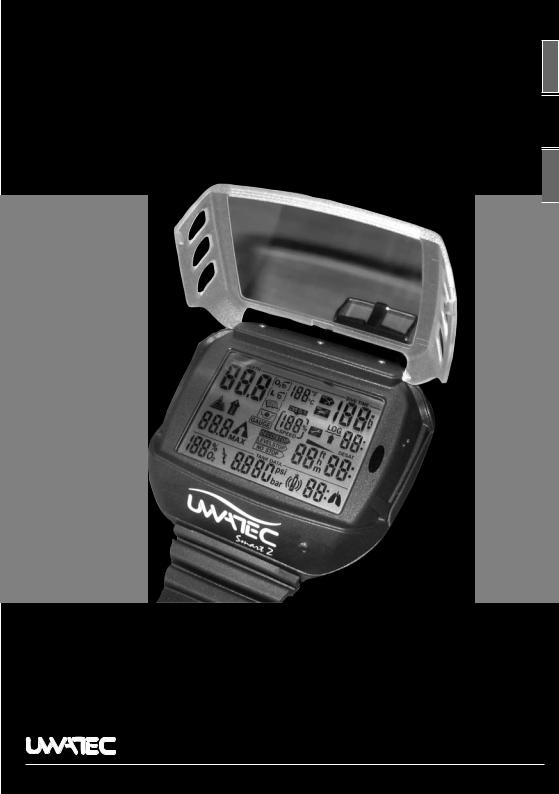
Operating Manual
Smart Z
 ®
®
SWISS MADE BY UWATEC AG
 Français English Deutsch
Français English Deutsch

Safety considerations
You must carefully read and understand this entire manual before using your new computer.
Diving has many inherent risks. Even if you follow the instructions of this
manual in a careful manner, it is still possible that you may be seriously injured
WARNING or die from decompression sickness, oxygen toxicity or some other inherent risk of scuba with Nitrox or compressed air. Unless you are fully aware of these
risks and are willing to personally accept and assume responsibility for those risks, do not use the computer!
Guidelines for the use of your UWATEC dive computer:
The following guidelines are derived from the latest medical research and the recommendations of the American Academy of Underwater Sciences for diving with diving computers. Following these guidelines will greatly increase your safety while diving, but cannot guarantee that decompression sickness or oxygen toxicity will not occur.
•This computer is designed for dives with Nitrox (to a max.100% O2) and compressed air (21%O2) only. Do not use the computer for dives made with other mixed gases.
•It is absolutely necessary to check the set mixture before each dive and to compare it to the gas mixture currently used. Always remember: setting an incorrect mixture carries an inherent risk of decompression sickness and/or oxygen toxicity! Maximum deviation from the measured mixture must not exceed 1% O2. An incorrect gas mixture can be lethal!
•Only use this computer with open circuit breathing systems. The computer must be set for a determined gas mixture.
•Only use this computer for diving with an independent breathing apparatus. The computer is not designed for long term exposures with Nitrox.
•Always observe the visual and audible alarm signals of the computer. Avoid situations of increased risk which are marked with a warning sign in this operating manual.
•If the ascent arrow appears, start to ascend. 
•If the flashing ascent arrow appears, start to ascend immediately.
•This computer has a ppO2 warning, the default limits of which are set at 1.4 bar ppO2max. This limit can be adjusted via SmartTRAK. An alteration of the ppO2max to higher than 1.6 bar is dangerous and we do not recommend this.
•Frequently check the "oxygen clock" (CNS O2), especially in the range higher than 1.4 bar ppO2. Ascend and finish the dive if the CNS O2 exceeds 75%.
•Never dive deeper than the Maximum Operating Depth (MOD) pertinent to the gas mixture in use.
•Always check the diving limits considering the oxygen content and standard sports diving procedures (decompression sickness, oxygen toxicity).
•In accordance with the recommended maximum diving limit of all instructional agencies, do not dive deeper than 40 metres/130 feet.
•The danger of nitrogen narcosis has to be taken into consideration. The computer gives no warning about this.
•On all dives, with or without dive computer, make a safety stop for at least 3 minutes at 5 metres (15 feet).
•All divers using dive computers to plan dives and indicate or determine decompression status must use their own computer, which they take with them on all dives.
•If the computer fails at any time during the dive, the dive must be terminated, and appropriate surfacing procedures (including a slow ascent and a 3 to 5 minute safety stop at 5 metres /15 ft) should be initiated immediately.
•Comply with the ascent rate and carry out any decompression stop required. If the computer should fail for any reason, you must ascend at a rate of 10m (30 feet) per minute or less.
•On any given dive, both divers in a buddy pair must follow the most conservative dive computer for that particular dive.
•Never dive without a buddy. Smart Z does not substitute for a dive buddy.
•Onlymakedivesthatareappropriatetoyourlevelofdivetraining.Adivecomputerdoesnotincreaseyour knowledge of diving.
2 |
UWATEC® Smart dive computers |
|

Safety considerations |
I |
|
|
|
|
• Always dive with back-up instruments. Make sure that you always use back-up instrumentation |
|
|
including a depth gauge, submersible pressure gauge, digital bottom timer or dive watch, and have |
|
|
access to decompression tables whenever diving with a dive computer. |
|
|
• Avoid repeated ascents and descents (yo yo diving). |
|
|
• Avoid repeated heavy workload while at depth. |
|
English |
• After finishing the decompression or at the end of a no-stop dive, the final stage of the ascent should |
||
• Plan the dives to be shorter if they are made in cold water. |
|
|
be as slow as possible. |
|
|
• You MUST be familiar with all signs and symptoms of decompression sickness before using this com- |
|
|
puter! Seek IMMEDIATE treatment for decompression sickness should any of these signs or symptoms |
|
|
occur after a dive! There is a direct correlation between the effectiveness of treatment and the delay |
|
|
between the onset of symptoms and the treatment for decompression sickness. |
|
|
• Only dive with Nitrox after you have been thoroughly instructed by a recognised institution. |
|
|
Repetitive dives |
|
|
• Do not start your next dive before your CNS O2% status has dropped below 40%. |
|
|
• Diving with Nitrox: Make sure your surface interval is long enough (just like diving with compressed |
|
|
air). Plan for a minimum surface interval of two hours. Oxygen, too, needs sufficient time to leave |
|
|
the body. |
|
|
• Match gas mixture to the intended dive. |
|
|
• Do not attempt a repetitive dive if the microbubble warning NO |
is visible on the display. |
|
•Plan a day without diving once a week.
•If you have to change computers, wait at least 48 hours before carrying out your next dive.
Altitude and diving
•Do not dive at altitudes higher than 4000m (13000 feet).
•After a dive do not rise to altitudes that the computer prohibits via the flashing altitude segments (see page 25).
Flying after diving
•After diving, wait at least 24 hours prior to flying.
Smart Z dive instrument is a personal protective equipment in compliance with the essential safety requirements of the European Union directive 89/686/EEC. RINA SpA, Via Corsica 12, I-16128 Genoa, notified body no. 0474, have certified the conformity with the European Standard EN 250:2000 and EN 13319:2000.
EN250:2000 Respiratory equipment - Open circuit self contained compressed air diving apparatus - Requirements, testing, marking (pressure gauge test).
EN13319:2000 Diving accessories - Depth gauges and combined depth and time measuring devices - Functional and safety requirements, test methods. Any information on decompression obligation displayed by equipment covered by this standard is explicitly excluded from its scope.
UWATEC® Smart dive computers |
3 |
|
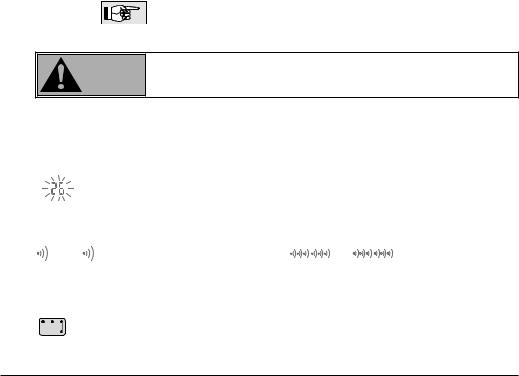
Introduction 
Congratulations on purchasing a Smart Z dive computer and welcome to UWATEC. From now on you will enjoy the assistance of the most extraordinary dive computer - equipped with UWATEC's most innovative technology - while diving.
We thank you for choosing this computer and we hope you will enjoy safe dives in the future! Further information on UWATEC Smart dive computers and other products by UWATEC can be found on our web page at www.uwatec.com.
To make this manual easier to read we will use the term 'Smart Z' as an abbreviation for 'UWATEC Smart Z diving computer' throughout this booklet.
Safety considerations
Dive computers provide divers with data; they, however, do not provide the knowledge how this data should be understood and applied. Dive computers cannot replace common sense! You must therefore carefully read and understand this entire manual before using your Smart Z.
Important remarks concerning signal words and symbols
This operating manual makes use of the following icons to indicate especially important comments:
Remarks |
Information and tips which are important for optimal use of the functions of |
|
Smart Z. |
Danger!
Indicates a potentially hazardous situation which, if not avoided, could result WARNING in death or serious injury.
The following symbols are used in the operating manual:
|
Flashing display |
-> Page reference |
|
|
e.g. ->10 |
Audible signals |
|
|
4 sec. |
Audible attention signal |
Audible alarm signal |
Instructions for manual input |
|
|
– + E |
Bridge contacts |
|
Example: bridging contacts B and E
B
April 2005, Copyright© by UWATEC Switzerland
4 |
UWATEC® Smart dive computers |
|

Quick reference |
I |
|
O2 mix icon (input) |
Temperature |
|
|
||
Microbubble level icon (input / MB level reduced) |
Do not fly icon |
|
Logbook icon |
||
Do not dive icon |
||
Dive planner icon |
Microbubble warning |
Current depth |
NO |
Dive time / No-fly time / SOS duration |
|
NO |
Service icon |
Gauge icon |
|
|
|
CNS O2% |
||
|
|
|
|
|||
Altitude sections |
|
|
|
|
||
Too fast ascent |
|
|
DECO STOP |
|||
Ascent obligation |
|
|
|
|||
|
|
|
LEVELSTOP |
|||
|
|
|
||||
Maximum depth |
|
|
NO STOP |
|||
|
|
|
|
|||
Microbubble level |
% |
|
|
|||
Maximum Operating |
|
|
||||
Depth (MOD) |
|
|
|
|
||
O2 mix |
|
|
|
|
||
Transmitter warning |
||||||
|
|
|||||
Decompression stop obligation |
||||||
|
|
Ignored decompression stop |
||||
Logbook indicator
Total ascent time / Dive number
Ascent time icon
Desaturation time indicator
No-stop time / Decompression duration / MB no-stop time
Level stop duration / Duration of Microbubble Warning
Desaturation duration / Duration of surface interval
Increased workload warning
Remaining bottom time RBT
Tank pressure warning
Tank pressure / Gas consumed |
Decompression depth / Level stop depth |
|
Partial pressure of oxygen ppO2 |
Oxygen toxicity CNS O2% |
|
Level stop indicator |
||
Ascent rate |
||
No-stop indicator |
Battery capacity |
|
Decompression stop indicator |
|
English
Operating scheme
Start / Confirmation / Enter
+ / Navigate
– / Navigate
Display switched off
Switching on
Dive planner |
Logbook |
|
O2 mix |
|
Microbubble level |
Gauge mode |
|||||
|
|
|
|
|
Navigation |
|
|
|
|
|
|
( |
|
|
|
) |
% |
|
|
|
|
|
|
+ |
Surface |
|
|
|
|
|
|
|
|||
– |
interval |
CNS O2% |
% |
|
|
|
|
|
|||
|
|
|
|
|
|
||||||
|
|
|
|
|
|
|
|
|
|
||
|
|
|
|
|
Battery capacity |
+ |
Percentage |
|
|
|
|
|
|
|
CNS O2% |
% |
– |
of oxygen |
|
|
|
|
|
|
|
|
|
+ |
|
+ |
|
||||
|
|
|
|
|
|
|
|
Microbubble |
Gauge mode |
||
|
|
NO STOP |
|
|
|
|
– |
level |
– |
on and off |
|
|
% |
|
|
|
|
|
|
||||
|
|
|
|
+ |
Dive number |
|
|
|
|
|
|
|
|
+ |
|
– |
|
+ |
operatingMaximum |
|
|
|
|
|
|
Bottom time |
|
|
|
|
|
||||
|
|
– |
|
|
|
– |
depth (MOD) |
|
|
|
|
|
|
Exit (2 sec.) |
Exit |
Confirmation |
Confirmation |
Confirmation |
|||||
Display switches off automatically after 3 minutes without operation.
UWATEC® Smart dive computers |
5 |
|

List of chapters 
I |
Safety considerations |
___________________________________2 |
|
|
Introduction |
___________________________________4 |
|
|
Important remarks concerning signal words and symbols ______________________________4 |
||
|
Quick reference / Operating scheme |
___________________________________5 |
|
|
List of chapters |
___________________________________6 |
|
II |
System and operation |
___________________________________8 |
|
1 |
System description |
___________________________________8 |
|
2 |
Operation |
___________________________________8 |
|
|
2.1 |
Operating elements |
___________________________________8 |
|
2.2 |
SmartTRAK |
___________________________________9 |
|
2.3 |
Switching on the display |
__________________________________10 |
|
2.4 |
Checking the battery capacity |
__________________________________10 |
|
2.5 |
Selection and activation of user functions |
__________________________________10 |
|
2.6 |
Active backlight |
__________________________________11 |
|
2.7 |
Switching off the display |
__________________________________11 |
3 |
SOS mode |
__________________________________11 |
|
4 |
Setting up Smart Z |
__________________________________12 |
|
|
4.1 |
Mounting of transmitter |
__________________________________12 |
|
4.2 |
Pairing of transmitter and dive computer |
__________________________________13 |
III |
Diving with Smart Z |
__________________________________15 |
|
1 |
Terminology / Symbols |
__________________________________15 |
|
1.1General terminology / Display during no-stop phase __________________________________15
1.2Display during decompression phase /
|
Remaining Bottom Time |
__________________________________15 |
1.3 |
Nitrox information (O2 information) |
__________________________________16 |
2 Attention messages and alarms |
__________________________________17 |
|
2.1 |
Attention messages |
__________________________________17 |
2.2 |
Alarms |
__________________________________17 |
3 Preparation for the dive |
__________________________________18 |
|
3.1 |
Setting the gas mixture and MOD |
__________________________________18 |
3.2 |
Setting the MB level |
__________________________________18 |
3.3 |
Preparation for the dive and function check |
__________________________________18 |
4 Functions during the dive |
__________________________________19 |
|
4.1 |
Immersion |
__________________________________19 |
4.2 |
Dive time |
__________________________________19 |
4.3 |
Current depth |
__________________________________19 |
4.4 |
Maximum depth |
__________________________________19 |
4.5 |
Temperature |
__________________________________19 |
4.6 |
Ascent rate |
__________________________________19 |
4.7 |
Partial pressure of oxygen (ppO2) / Maximum Operating Depth (MOD) ___________________20 |
|
4.8 |
Oxygen toxicity (CNS O2%) |
__________________________________21 |
4.9 |
Tank pressure |
__________________________________21 |
4.10 Remaining Bottom Time (RBT) |
__________________________________22 |
|
4.11 Decompression information |
__________________________________22 |
|
5 Functions at the surface |
__________________________________24 |
|
5.1 |
End of a dive |
__________________________________24 |
5.2 |
Desaturation time |
__________________________________24 |
5.3 |
No-fly time |
__________________________________24 |
5.4 |
Microbubble warning |
__________________________________24 |
6 |
UWATEC® Smart dive computers |
|

List of chapters |
I |
||
6 |
Diving in mountain lakes |
__________________________________25 |
|
|
6.1 |
Altitude ranges |
__________________________________25 |
|
6.2 |
Prohibited altitude |
__________________________________25 |
|
6.3 |
Decompression dives in mountain lakes |
__________________________________25 |
IV |
Gauge mode |
__________________________________26 |
|
V |
Diving with microbubble levels (MB) |
__________________________________28 |
|
1 |
Comparison of dives with MB level L0 and MB level L5 |
__________________________________28 |
|
2 |
Terminology |
__________________________________29 |
|
|
2.1 |
Display during microbubble (MB) no-stop phase |
__________________________________29 |
|
2.2 |
Display during level stop phase |
__________________________________29 |
3Preparation for a dive with microbubble levels (MB levels) __________________________________30
|
3.1 |
Setting the MB level |
__________________________________30 |
4 |
Functions during the dive with microbubble levels |
__________________________________30 |
|
|
4.1 |
Level stop information |
__________________________________30 |
|
4.2 |
Total time of ascent |
__________________________________31 |
|
4.3 |
Decompression obligation |
__________________________________31 |
|
4.4 |
Level stop and deco stop |
__________________________________32 |
5 |
Complete a dive with MB levels |
__________________________________32 |
|
VI |
Dive planner |
__________________________________33 |
|
1 |
Planning a no-stop dive |
__________________________________33 |
|
2 |
Planning a decompression dive |
__________________________________34 |
|
3 |
Leaving the dive planner |
__________________________________34 |
|
VII |
Logbook |
__________________________________35 |
|
1 |
Survey |
__________________________________35 |
|
2 |
Operation |
__________________________________35 |
|
VIII Appendix |
__________________________________36 |
||
1 |
Technical information |
__________________________________36 |
|
2 |
Maintenance |
__________________________________36 |
|
|
2.1 |
Replacing the battery of the transmitter |
__________________________________36 |
3 |
Conversion of tank pressure |
__________________________________38 |
|
4 |
Warranty |
__________________________________38 |
|
5 |
FCC |
|
__________________________________39 |
6 |
Index |
__________________________________39 |
|
English
UWATEC® Smart dive computers |
7 |
|

II System and operation 
1 System description
Smart Z displays all important dive and decompression data and comes with a unique receiver which can receive tank pressure data from a transmitter. Mounted at the high pressure (HP) outlet of the regulator, the transmitter measures the tank pressure and radio transmits the information to Smart Z. UWATEC's specially patented transmission process prevents interference and ensures continuous and reliable reception.
Smart Z has a data memory which stores the dive data. The data can be transmitted with an infrared interface (IrDA) and the SmartTRAK software to a Windows® personal computer.
The SmartTRAK CD software is included with the Smart Z Package. Infrared interfaces are available in PC stores. A list of recommended interfaces is available on the UWATEC homepage (www.uwatec.com).
Infrared port |
SmartTRAK |
|
Pressure transmitter |
Infrared Interface |
|
|
|
(option) |
2 Operation
On page 5 you will find an operating schematic.
2.1 Operating elements Contacts
Smart Z has 4 operating contacts B, E, +, – on the outside of the housing. For manual operation, touch base contact B and any one of the other three contacts above the display with moistened fingers («bridging» contacts).
Contact B: Base contact, which has to be touched for all operations.
Contact E: Enter contact. It serves to switch on Smart Z and to confirm or enter the displayed value. It is therefore comparable to the ENTER or RETURN key of a keyboard.
+ / – Contacts: These allow to navigate between menus and, once inside a menu, to increase or decrease the indicated value.
8 |
UWATEC® Smart dive computers |
|
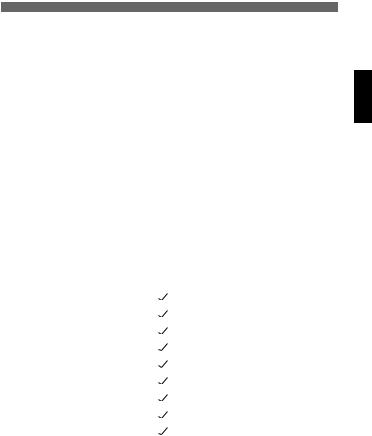
II System and operation |
II |
2.2 SmartTRAK
With SmartTRAK you can transfer dive data to a personal computer and graphically display the data.
The following settings may be changed with SmartTRAK: |
|
• Unit system |
metric/imperial |
• Audible attention signal suppression |
selective |
• Gauge mode |
on / off |
• Depth alarm |
5 - 100 m (20 - 330 feet) |
• Backlight illumination duration |
2-12 sec. |
• Maximum partial pressure of oxygen (ppO2 max) |
1-1.95 bar |
• Time limit to reset the O2 % mix to air |
no reset / 1 - 48 hrs. |
• Minimum reserve pressure at the end |
|
of the dive (basis for RBT calculation) |
20 – 120 bar (300 - 1750 psi) |
• Tank pressure alarm |
50 - 200 bar (750 - 2900 psi) |
• Workload sensitivity |
25 steps |
The following data may be recalled with SmartTRAK: |
|
• Number of past dives |
|
• Total duration of past dives |
|
• Atmospheric pressure |
|
• Pairing information |
|
• Dive profile |
|
• Logbook |
|
• Temperature curve |
|
• Workload curve |
|
• Alarms and attention messages |
|
English
UWATEC® Smart dive computers |
9 |
|

2 Operation 
2.3Switching on the display
•automatically, on submerging in water or when adaptation to atmospheric pressure is necessary;
•manually, by bridging contacts on housing (B-E).
NO
NO
CNS O2%
DECO STOP
LEVELSTOP
NO STOP




 %
% 


Temperature
O2 Mix

 %
%
Do not fly icon
NO

 No-fly time
No-fly time
CNS O2%
Oxygen toxicity




 Desaturation time
Desaturation time
%
•When Smart Z is in state of rest no information is displayed but the atmospheric pressure is continuously monitored. If a higher altitude range is detected, Smart Z switches on for 3 minutes automatically -> 25.
•Smart Z switches on by bridging the contacts B and E. All segments light up for 5 seconds.
Afterwards the display shows the selected O2 mix, the temperature and in certain circumstances an altitude range ->25.
If the transmitter is switched on and located within transmitting distance, the tank pressure is displayed, otherwise "---" will be displayed. If no transmitter has been paired yet, the display will be blank.
If there is a remaining saturation due to the last dive or change of altitude, Smart Z also displays the remaining desaturation time, the oxygen toxicity and the "no-fly time" ->24.
2.4 Checking the battery capacity
|
|
After switching on Smart Z you can check the battery capacity by bridging |
|
|
|
||
|
|
the contacts B and E. The remaining capacity is displayed for 3 seconds as |
|
|
|
a percentage. If the value reaches 0%, the battery warning gets activated |
|
|
|
(->17) and the battery has to be replaced by an authorised SCUBAPRO UWATEC |
|
Battery capacity |
dealer. |
||
For a 7-day diving vacation Smart Z uses between 2 – 5 % of its battery capacity. |
|||
|
|
||
|
|
|
|
2.5 Selection and activation of user functions |
|||
Gauge mode ->26
Input microbubble level ->30 Input O2 mix ->18
Logbook ->35 Dive planner ->33
At the surface you can select the dive planner, the logbook and gauge mode as well as the functions to enter the O2% mix and the microbubble levels by bridging the contacts + and B or – and B.
After the selection of the desired function you can activate and deactivate it by bridging the contacts B and E.
Details to the user functions are to be found on the pages mentioned above.
10 |
UWATEC® Smart dive computers |
|
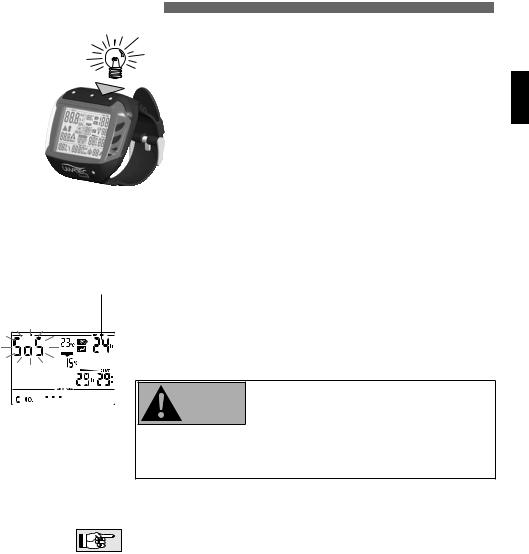
2 Operation / 3 SOS mode |
II |
2.6 Active backlight |
|
|
The display of Smart Z can be illuminated both on the surface |
|
and underwater. |
|
The backlight can be activated by pressing on top of the case. |
|
The light will turn off automatically after 8 seconds or after the |
|
time selected via SmartTRAK. |
|
The backlight can only be activated if the computer display is |
|
on. |
English
2.7 Switching off the display
On the surface Smart Z switches off automatically after 3 minutes without operation.
3 SOS mode
Time remaining until SOS mode switches off automatically
NO
NO
CNS O2%

 %
%
Activation: automatic
If the diver remains above a depth of 0.8m (3 feet) for more than three minutes without observing a prescribed decompression, the computer will automatically switch into SOS mode after the dive.
The display shows the "SOS" sign and the remaining length of the SOS mode. The dive will be entered in the logbook with "SOS". Other than that the SOS mode has no further impact on the displays and functions on the surface.
• Serious injury or death may result if a diver does WARNING not seek immediate treatment should any signs or symptoms of decompression sickness occur
after a dive.
•Do not dive to treat symptoms of decompression sickness!
•Diving in SOS mode is extremely dangerous and you must assume full responsibility for such behaviour. UWATEC will assume no liability.
Once in the SOS mode, the computer will lock up and will be inoperable as a diving instrument for 24 hours.
A diving accident can be analyzed at any time in the logbook and downloaded to a PC by means of the infrared interface (IrDA) and the SmartTRAK software.
UWATEC® Smart dive computers |
11 |
|
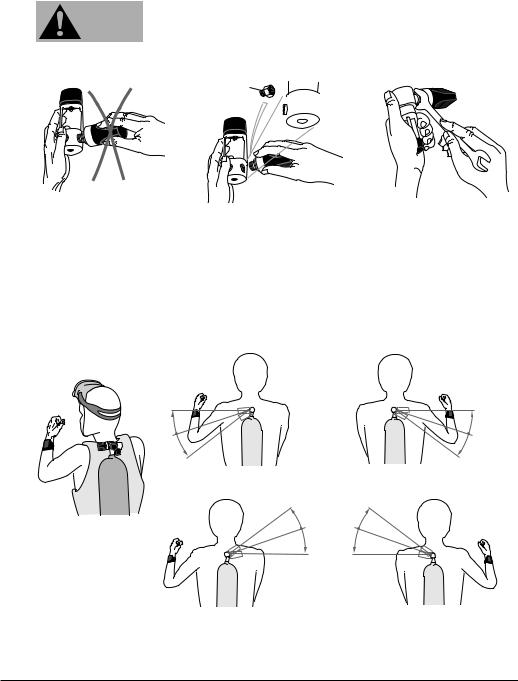
4 Setting up Smart Z (transmitter and dive computer) 
4.1 Mounting of transmitter
The transmitter is mounted at the high pressure (HP) outlet of the regulator’s first stage before the first dive.
WARNING |
Use air and Nitrox components in accordance with the law of the country. |
|
|
|
|
Procedure: |
|
(Adaptor)

 HP
HP

Do not hold the transmitter by its plastic part.
Mount the transmitter at the HP |
Tighten the transmitter by |
oulet. If the threads do not match, |
means of a size 3/4" wrench. |
you can get a fitting adaptor at your |
|
diving equipment retailer. |
|
The transmitter is best mounted laterally on the regulator.
It is advisable to mount the transmitter on the same side that the computer is located. This is the optimal position for transmission.
Position of the transmitter |
Position of the transmitter |
for left handers. |
for right handers. |
Position of the transmitter for left handers, if there is no connection possible on the left hand side.
Position of the transmitter for right handers, if there is no connection possible on the right hand side.
12 |
UWATEC® Smart dive computers |
|
